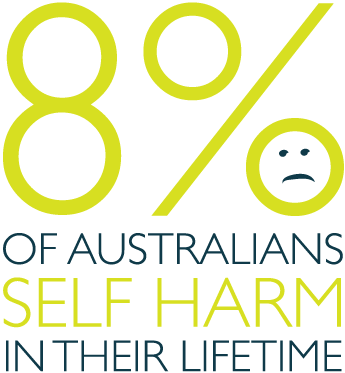Mental Illness Isn’t Just Skin Deep

Sarah Bloomhill is a 22-year-old university student — and from where she sits at a Sydney cafe — there seems to be nothing out of the ordinary about her.
Her hair is piled into a neat bun and she is wearing a short polka dot dress, appropriate for the warm spring weather. However, as soon as she shifts in her chair, something less ordinary is revealed. As she moves, the hem of her dress lifts a little to expose several lines of thick, raised scar tissue. One would assume surgery, or an accident of some sort. In each case, your assumption would be incorrect. Sarah’s scars are self-inflicted.
 Sarah is one of the estimated 440,000 Australians who suffer from Borderline Personality Disorder (BPD) as a mental illness. BPD is the most serious of personality disorders, of which deliberate self-harm and impulsive behaviour are main characteristics. Self-harm takes the form of any conscious act to injure oneself, without the intent of suicide.
Sarah is one of the estimated 440,000 Australians who suffer from Borderline Personality Disorder (BPD) as a mental illness. BPD is the most serious of personality disorders, of which deliberate self-harm and impulsive behaviour are main characteristics. Self-harm takes the form of any conscious act to injure oneself, without the intent of suicide.
“I self-harm when I’m dealing with extremely intense emotions and I don’t know how to cope, or if I’m feeling really worthless and disgusting,” Sarah says. “I self-harm by cutting, and it’s usually on my thighs.”
Research shows that about 8% of Australians have self-harmed within their lifetime. Although one would expect that self-harming acts are inherently painful, Sarah reports feeling little to no pain during the act.
“At the beginning when I started doing it, I’d only really graze the surface of my skin, but that quickly escalated. There have been many times my wounds have been so deep I’ve needed emergency hospitalisation for stitches and loss of blood.”
Dr Carryn Masluk, a specialist in BPD, explains that frequent self-harming may lead to a built up pain tolerance. She says, “Individuals may have to engage in more medically severe self-harm to get the same relief they did earlier on. This is a major concern as it becomes more lethal as time progresses.”
A recent study published in the Journal of European Child and Adolescent Psychiatry has shown that adolescents with BPD have a higher overall pain threshold than healthy control participants. This makes BPD suffers even more susceptible to self-harming, as their ability to acknowledge pain diminishes.
Sarah says that self-harm became an ‘addiction’, and at her lowest point she was self-harming several times daily. “It consumes your day,” she says. “You plan everything around self-harming.”
Dr Masluk says, “Self-harm behaviour is very addictive because it works. Self-harm is immediately followed by a sense of relief from an intensely painful emotional state. This change is in itself very reinforcing and increases the likelihood that the person will do it again and again.”
“Furthermore, research shows that self-harm can lead to the release of natural painkillers in the body known as endorphins, which again provides a sense of relief.”
A study by Brock University’s Department of Psychology indicated that self-harmers who engaged in the act with the intent to ‘self-punish’ tolerated pain significantly longer than self-harmers without self-punishing motivations.
Self-punishment plays a large role in Sarah’s motivations to self-harm. “I feel like a failure of a human being and that I deserve pain,” she says. However, there are a variety of other motivations to self-harm.
Mara Vinsi, aged 20, also suffers from BPD. She self-harms by means of scratching herself with fingernails, deeply enough to draw blood. While, unlike Sarah, her self-harm has never needed urgent medical assistance, her scratching has left visible discoloured markings on her forearms.
She says, “I use self-harm a lot as a way to physically experience my emotional pain and make it more real. Honestly, in the past I’ve also used it as a way to show other people, especially mum and dad, how much I’m hurting. I don’t know how else to express what I’m going through.”
Mara’s father, Carl Vinsi, constantly worries for her safety. He says, “We feel completely helpless because it’s so out of our control. We don’t want Mara to go through all this pain, but she does, and it’s sad. Whenever I find out she’s done it I feel all this confusion and frustration because it’s just something I don’t understand.”
Melissa McNamee, clinical psychologist, is not surprised by Mara using self-harm as a means of communication, and believes that such situations are quite common in those suffering from BPD or depression. She says that this may be interpreted as attention seeking, but it is usually only enacted with the intention of seeking help.
Mrs McNamee says that one of the methods she recommends in dealing with self-harm is known as ‘urge surfing’.
“The idea is that instead of giving into the feeling, you ride the urge like a surfer rides a wave, knowing that after a specific amount of time has passed the urge usually subsides,” she says.
“That actually came out of the research on quitting smoking. So for example, if you’re having the urge to smoke a cigarette and you’re able to do something else to distract yourself and resist the urge, then sometimes the urge passes.”
Psychotherapy and community support groups are helpful long term interventions for those struggling with self-harm. Dialectical behaviour therapy (DBT) is a skills-training course specifically targeted at individuals diagnosed with BPD, and has the highest levels of evidence of effective treatment.
Lyndon Barei, DBT practitioner, says, “The skills taught in DBT help people to observe urges to self-harm without acting on them, and to utilise distraction and distress tolerance strategies when the urge to self-harm is high.”
However, in a survey by Australia’s Private Mental Health Consumer Carer’s Network (PMHCCN), over half BPD sufferers said that they lacked access to services such as DBT, mostly due to problems with waiting lists and financial barriers. DBT also requires a high level commitment from the patient, as it typically involves weekly sessions over the course of a year. A further report published by the PMHCCN states that sufferers of BPD are among those with the highest levels of unmet need in Australian mental health services.
One of Sarah’s measures to help prevent her from self-harming is simply a list of pros and cons she has permanently stuck to her bedroom wall.
“I listed the short term versus long term effects of self-harming and weighed them up. Really summarised— there’s the short term pro of instant emotional release and the long term con of hospitalisation and stitches if it gets that bad, and of course the scarring and shame.”
“During hot weather like today where I tend to wear shorter clothes, I’ve literally been asked by strangers in public about my scars. It’s terrible. I hate the amount of judgement I get from other people and the way people look at you.”
Nevertheless, Sarah says she’s slowly learnt to come to terms with her scars.
“It’s been hard dealing with the shame. But I think I’ve gotten the point now where I’m like, yeah I have these scars, but they’re a part of me now, and I have to accept the repercussions of the choices I’ve made.”
Sarah raises her dress slightly to expose the thick pinkish-purple scars across her thighs.
“For anyone thinking about self-harming — don’t do it. I’m okay with my scars now, but seriously, they’re so ugly to look at. It isn’t worth it and once you start you just can’t stop. Don’t do it.”
Sarah hopes that with perseverance, therapy and support from her family and close friends, she may one day have the strength to entirely resist all urges to self-harm and rely on safer methods of coping with BPD.
For support regarding Borderline Personality Disorder or self-harm, call Lifeline on 13 11 14 or visit www.lifeline.org.au. If you require urgent medical attention, dial 000 for an emergency.
Written By
Naz Jacobs
Newsletter
Stay up to date
Sign up to our Mind Reader newsletter for monthly mental health news, information and updates.